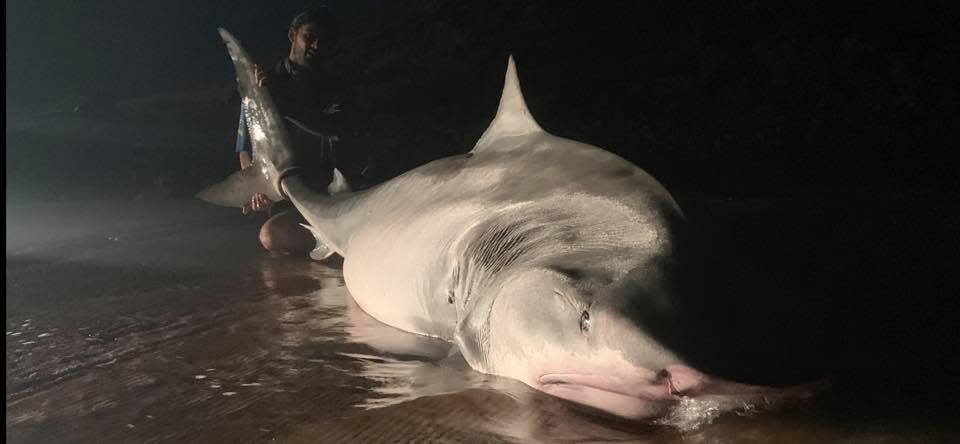Trophy photo of massive tiger shark sparks heated debate
Days after conservation groups called for tiger sharks to be listed as endangered, a man’s “trophy photo” with one of the predators in Western Australia has sparked heated debate.
In one image, published to a public shark fishing Facebook page, fisherman Kruz Mettner smiles as he holds open the jaws of the five-metre-long animal.
Another photo shows him holding up the tiger shark’s tail as it lies beached in shallow water.
In a third photo, the shark lies near the shoreline and is secured by a rope.

Mr Mettner told Yahoo News Australia that the feeling of catching and then posing with a shark is “indescribable”.
“When you catch a shark and you see that dorsal fin coming up, it’s kind of mind blowing.
“You get real close and interact with it, you see its eye up real big, you feel its skin it’s like sandpaper - it’s really crazy.”
The Sharky - Pilbara Land base shark fishing Facebook page where the images were posted states that the group release the animals they catch, but this hasn’t quelled a tide of anger from social media users.
“I am such a he-man! I desperately need your approval and attention,” said one comment.
“Not cool dude,” wrote someone else.
Supporters of the fisherman congratulated him, advising that he “ignore the haters”.
“Nice work boys, better than the old days of cutting the jaws out just to hang in the patio,” one person said.
“Beast! Awesome effort guys,” said another.

‘I love my sharks’
Mr Mettner explained that he was fishing off a boat ramp when he hooked the tiger shark.
“We keep it just in the water to allow the tide to bring the water up through its gills, so we can keep it obviously a bit more alive,” he said.
“We normally take three photos, we take one on the side, one from an angle and then one head shot.
“The way we get it back in the water is we remove the hook, and then we grab that tail rope... and we pull that fish backwards into the water until it’s supporting its own weight.
“From there we’ll remove the tail rope and we’ll hold the fish, and we’ll push it out and send it on its way.”

Mr Mettner said that larger sharks have the strength to survive being hooked and photographed.
“I find tiger sharks and bull sharks, very, very, very hard creatures,” he said.
“If you’re dealing with something like a hammerhead, it will cause the animal heaps more stress as they can fight to near death.
“I love my sharks and we try and keep them alive and put them back in the water the way they originally were, beside a little hook mark on them.”
Catch and release still causes stress, expert says
Dr Leo Guida from Australian Marine Conservation Society noted text accompanying the photos said the shark had a “strong release”.
Dr Guida told Yahoo News Australia it appears the group is trying to do the right thing by catching and releasing, but warns against removing sharks from the ocean for “trophy shots”.
A keen fisherman himself, Dr Guida said he would love to speak with members of the shark fishing group so he can provide advice on handling the animals in a way that avoids stress or even death.
“Generally speaking, it’s best not to take trophy photos, and the reason being is you can put the animal under incredible stress,” he said.
"When sharks are out of the water, they start to suffocate because they're unable to get oxygen from the water running over their gills.
“Air exposure can also cause temperature shock from windchill, particularly in the colder seasons when the air temperature is colder than the water."

Decline in tiger shark numbers
Research published in the journal Biological Conservation, found a 71 per cent decline in Queensland tiger shark numbers over the last 33 years.
The Humane Society International and Australian Marine Conservation Society believe the steep drop qualifies the animals to be listed as endangered.
Dr Guida noted that tiger sharks swim for thousands of kilometres and travel the entire coast of Australia - meaning the Queensland population figures are an indicator of their national numbers.
In fact, the apex predators even swim into Indonesian waters where they are under threat from fishermen.
Dr Guida has urged fishermen to put their own welfare and the shark’s ahead of a photograph.
“Trophy photos aren’t the way to go,” he said.
Do you have a story tip? Email: newsroomau@yahoonews.com.
You can also follow us on Facebook and Twitter, download the Yahoo News app from the App Store or Google Play and stay up to date with the latest news with Yahoo’s daily newsletter. Sign up here.



